-
-
- Kitchen accessories
- Breathalyzers
- Blenders, mixers and planetary robots
- Electric kettles
- Coffee machines and coffee
- Waffle makers
- Frytownice (Air Fryer)
- Ice makers
- Microwaves
- Ovens and stoves
- Pressure cookers
- Soda makers
- Toasters, sandwich makers, electric grills
- Thermoses and thermal mugs
- Kitchen scales
- Irons and steamers
- Heaters
- Air treatment
- Fans and air conditioners
- Vacuum cleaners
-
- Locators
- Warranties and digital licenses
- Consoles and accessories
- Gsm accessories
- Cctv monitoring
- Tablets and e-book readers
- Photography
-
Network equipment
- Voip
- LTE, 5G
- Cables and patch cords
- Rack cabinet accessories
- Olt and ont
- Network accessories
- Wi-Fi / LTE antennas
- Enclosures, splices, boxes
- Rack cabinets
- Fiber optic welders and tools
- Access points
- Switches
- Uchwyty i akcesoria montażowe
- Sfp modules
- Power supply
- Wi-Fi signal boosters
- Routers
- Radio lines
- Powerline
- Cable pulling pilots
- Media converters
- Computers and gaming
- Drones and accessories
- Power supply
- Smart glasses
- Liczarki do pieniędzy
-
- Nasal aspirators
- Inhalers
- Lamps, star projectors
- Pregnancy pillows
- Bottle warmers
- Bottle sterilizers
- Children's thermometers
- Potty chairs and seats
- Lactation massagers
- Children's room
- Toys, games and education
- Bottles, bidons and accessories
- Breast pumps and accessories
- Bathtubs and bathing accessories
- Strollers for children
- Clothing
ubnt ltu performance test part 1
Ubiquiti LTU - Performance tests (Part 1)
With the arrival of Ubiquiti LTU (Long Term Ubiquiti), it's finally time to test the latest devices! Wojtek Repiński, who has been managing ICT and telecommunication resources for over 22 years, helped to carry out the tests. Additionally, 15 years of experience with MikroTik and Ubiquiti Inc. solutions and practical experience in the implementation and administration of WiMax and LTE networks allows for reliable tests.
At the beginning it is also worth mentioning that Ubiquiti LTU devices are incompatible (for the time being) with previous Ubiquiti airMAX and airFiber devices. This is partly a kind of inconvenience, as it prevents a smooth migration of existing radio networks using airMAX protocol compliant devices. At least this is currently the case in firmware version 2.0.6.-beta2.
www.batna24.com as one of the first in Poland provides performance tests for Ubiquiti LTU-Rocket and Ubiquiti LTU-Pro devices.Ubiquiti LTU vs Ubiquiti airMAX
Information contained in the device interface itself, namely in the PTMP Link Settings section, should fill us with optimism. There is a parameter here that cannot be modified at present:

However, in the help for this parameter we will find this information:
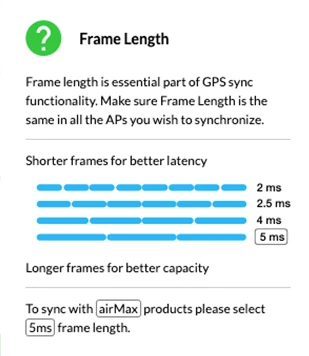
Therefore, we can hope that in future software versions compatibility with Ubiquiti products working in airMAX protocol will appear.
Specification Ubiquiti LTU
Devices based on the LTU protocol can operate in a wide frequency range, i.e. from 4800MHz to 6200MHz. Additionally, we can set optimal channel width (10,20,30,40,50 MHz) and work on 1024QAM modulation.
Ubiquiti Inc. announces that in the upcoming software updates we can expect to introduce a channel width up to 100MHz and modulation 4096QAM. Thanks to these changes it will be possible to achieve real bandwidth even up to 1Gbps (currently up to 600Mbps).
It is worth knowing that the Ubiquiti LTU product family is based on a dual-core ARMv7 Cortex A9 processor. Unfortunately for the moment we don't know yet what the processor clock rate is.
In short, both LTU-Rocket and LTU-Pro have virtually the same processor. Comparing the processor load of both devices, it can be assumed that the only difference between LTU-Rocket and LTU-Pro is that the LTU-Pro processor is clocked slower.
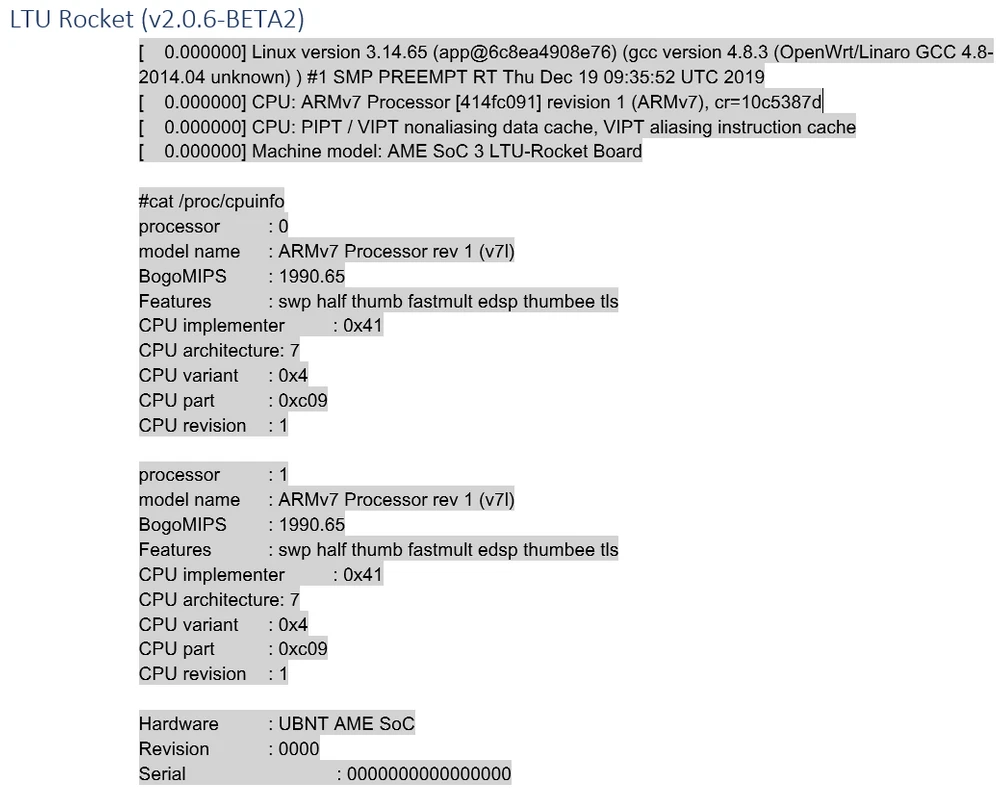
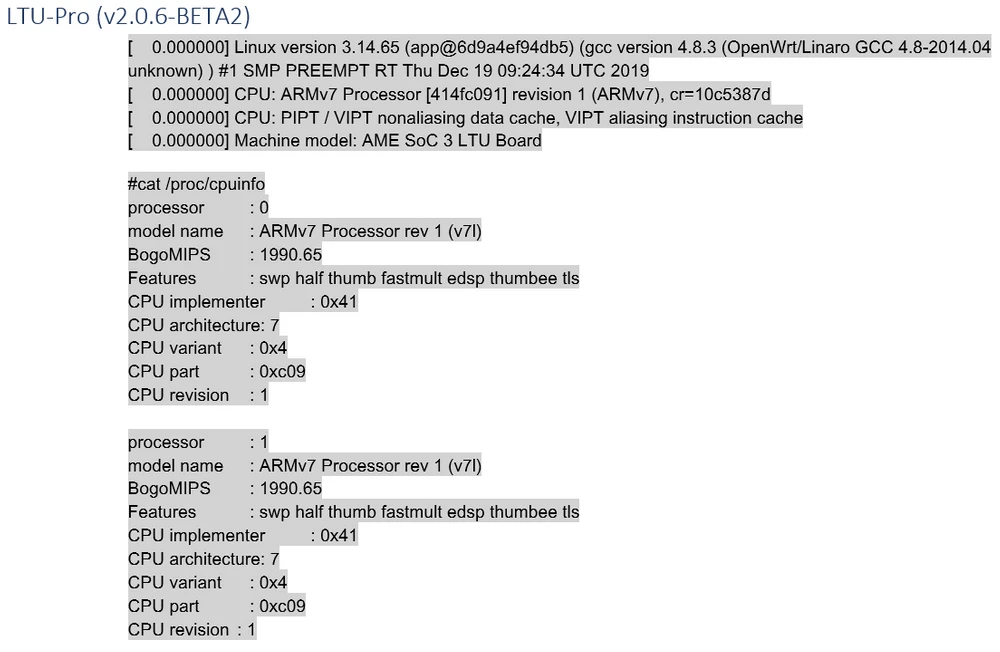
Ubiquiti LTU - quality workmanship and mounting accessories
Ubiquiti Inc. have already got us used to the good quality of their equipment. This is the case with LTU-Rocket and LTU-Pro. The quality of both devices is very good, although the manufacturer could take care of the reduction of plastics in LTU-Rocket, because the whole one side is made of plastic only.
In LTU-Pro, on the other hand, you may have some slight doubts about the mast attachment handle, which, except for the clamp itself, is made of a "light alloy". In addition, the paint applied gives a feeling of plastic (powder coating), but after scratching some paint off "metal" elements are clearly visible.
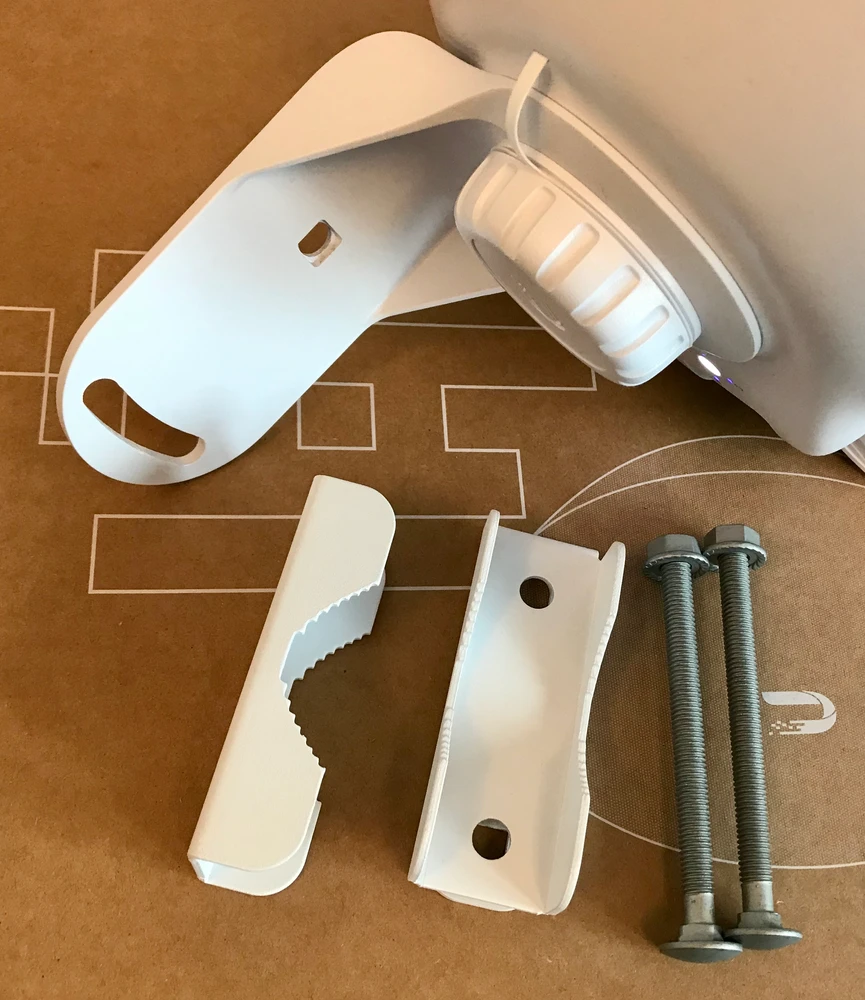
The way the handle is attached to the device's housing is a great advantage. Well, if we first mount the bracket to the mast (without the device), we can use it as an aiming mechanism!
The top edge of the handle allows you to optically aim exactly where the antenna is to be pointed at when it comes to the azimuth and tilt range.
Once the mast holder is properly attached, we can mount the antenna itself. A great advantage is the very easy way of mounting even when working at considerable heights, but Ubiquiti inc has already got us used to that.
Ubiquiti LTU GPS
"Both devices have a GPS module. LTU-Rocket is equipped with an external antenna, which is well known from previous products. In the case of LTU-Pro, the GPS antenna is built into the housing.
An interesting solution is also the gyroscope module included with the GPS, which gives tilt and rotation values of the antenna. Thanks to such a solution, adjusting and setting the antennas becomes a very pleasant activity. And the range of information displayed is really impressive.
In addition, the possibility of saving the antenna position setting allows you to re-align the antenna after service work, and also allows you to monitor possible changes in the antenna position (e.g. after strong gusts of wind or storms).
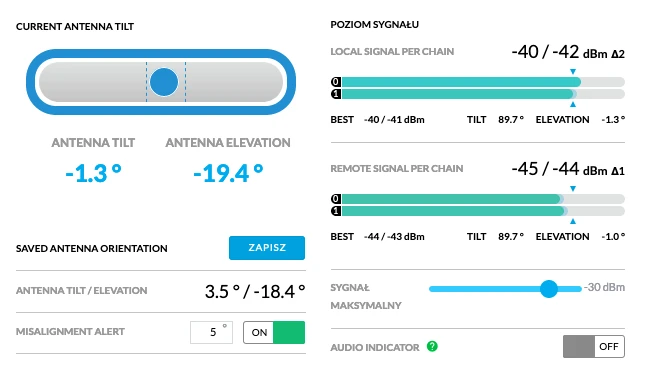
Test stand
Due to the season (winter) and current weather conditions, we were unable to test the equipment in the field. Therefore, Part 1 of the tests, will be based on "desk tests". In order to carry out the tests professionally, we used the following devices:
- 2x JDSU SmartClass Ethernet
- Network Analyzer Measall KC901V
- Mikrotik RB4011iGS+5HacQ2HnD-IN
- Ubiquiti LTU-Rocket
- Ubiquiti LTU-Pro
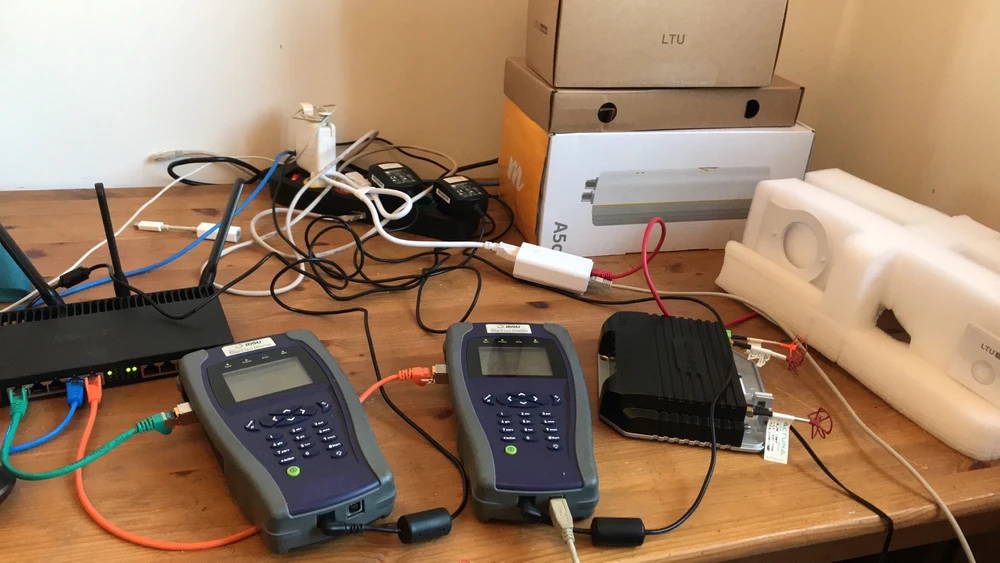
Ubiquiti LTU-Rocket has typical "stick" antennas from a 5GHz WiFi router. Of course, we are all aware of the big limitations and quality of the antennas, and the very imperfect one during the tests - all this certainly affected the results. Moreover, Ubiquiti LTU-Pro worked without GPS synchronization.
.LTU test results

* The last three tests require special attention:
- test no. 9 and 10: executed at an interval 5MHz between Tx and Rx
- test no. 11: executed at an interval 0MHz between Tx and Rx channels.
Network Analyzer
Tests made with a radio spectrum analyzer, show exactly what the broadcasting process looks like - no noise generated by the device itself.
Long Term Ubiquiti transmits exactly at the frequency specified in the settings and there is no descent slope, which is visible in many cheap solutions.
2x50MHz, separated by 5MHz of free band
Rx: 5980-6030MHz, Tx: 5925-5975MHz
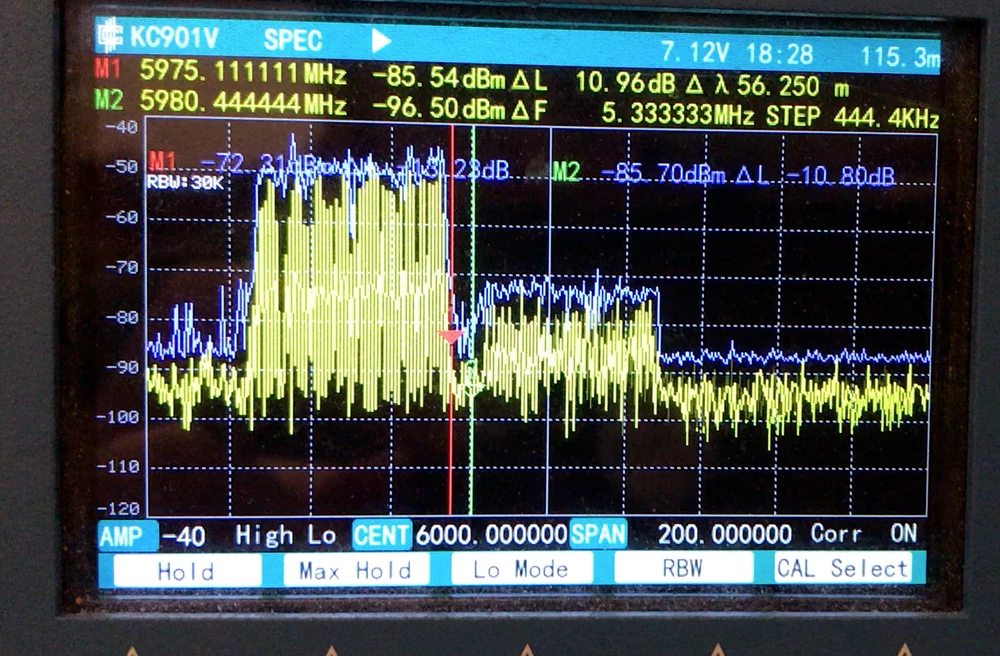
And here on a normal 50MHz channel: Tx and Rx 6025MHz - 6075MHz:
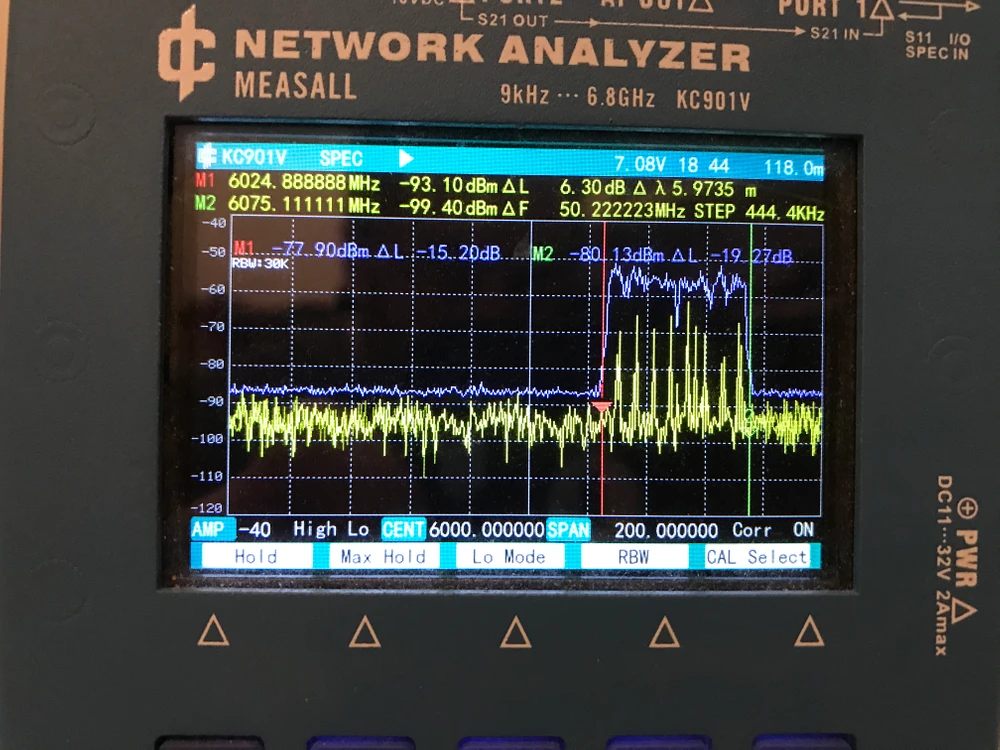
Packages per second (PPS)
The last test of the latest solutions Ubiquiti consisted of verifying the number of packages per second the device is able to handle. The results we obtained are really very good: 350kpps!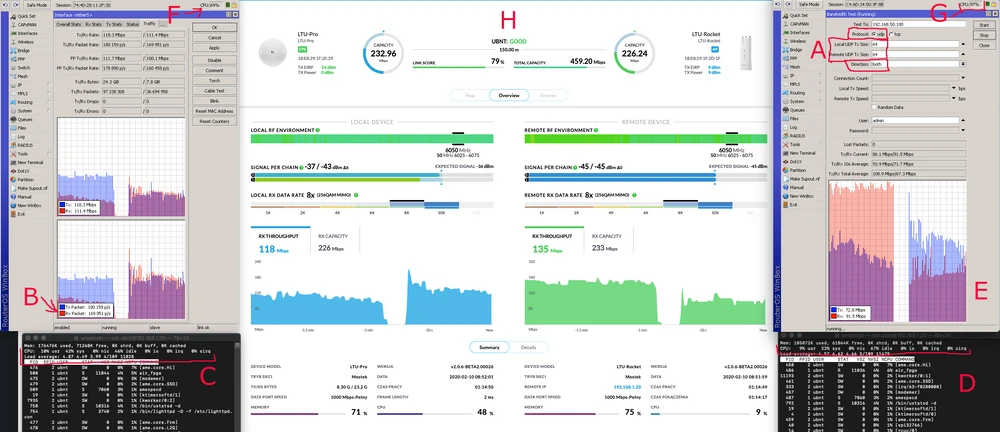
Key:
- UDP protocol, 64B frame length, two-way test
- Total 350kpps for 64B (sum of both directions) - no MicroTik device with higher performance pps, so performance information up to 2mln pps can be close to the truth.
- The CPE LTU-Pro load - CPU is still bored and maximum performance has not been reached
- Litux LTU-Rocket AP load - CPU is still bored and maximum performance has not been reached. Please note that AP (D) has less load than CPE (C)
- The performance achieved in Mbps, when the packet size is set to 1500B, is: speed = max - 10% shown at (H), for packet size 1500B .
- The CPU load of the device generating the tests on the AP side - as you can see, it still has a little bit of reserve
- The CPU of the device generating tests on the CPE side - device is 97% loaded and limits test performance
- LTU-Pro:
- Band set to test: 6025-6075MHz
- The 50MHz channel width
- The devices on the table, it was very difficult to get a stable link because of the interference and the proximity of the devices
- As you can see the devices did not set to the highest modulations
- AP - GPS synchronization
- CPE - no CPE synchronization, Synchronization only on NTP - LTU-Rocket AP has a better GPS antenna
- With CPE-side GPS synchronization you can get a bit better performance.
- The lack of GPS and NTP synchronization on the CPE side is associated with very poor results.
Summary
As you can see, Ubiquti LTU (Long Term Ubiquiti) devices impress with their performance. In this price range, such results have so far been unavailable. We are certainly waiting for the next versions of the software, which will unlock new functionalities. After the "desktop" performance tests, it can be said for sure that the Ubiquiti LTU family devices are worthy competitors for the Cambium ePMP3000 and Mimosa products. Additionally, handling so many packets per second (pps) certainly speaks in favor of Ubiquiti inc.
The only downside you could see is the lack of SFP modules. Unfortunately, the latest products from Ubiquiti are only equipped with Gigabit Ethernet, but among so many advantages and bandwidths of 500mbits, it's not so important.
As a reminder, we have already had the opportunity to carry out Long Term Ubiquiti field tests - airfiber LTU (airfiber 5xhd). To sum up, the new range of devices from Ubiquiti Inc. is an interesting alternative in the market of wireless solutions. It may even seem to be an alternative to current solutions in the WISP segment. Well, you obviously need to check the equipment in reality, because LTU seems very promising...
We also invite you to further discuss this topic at our FORUM
check_circle
check_circle
Menu
Filters
Loading...
